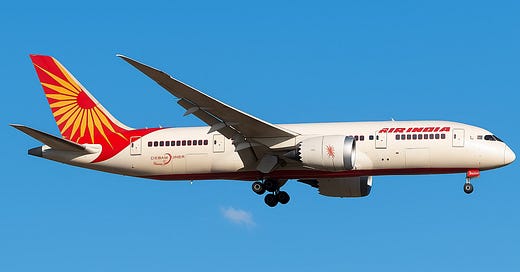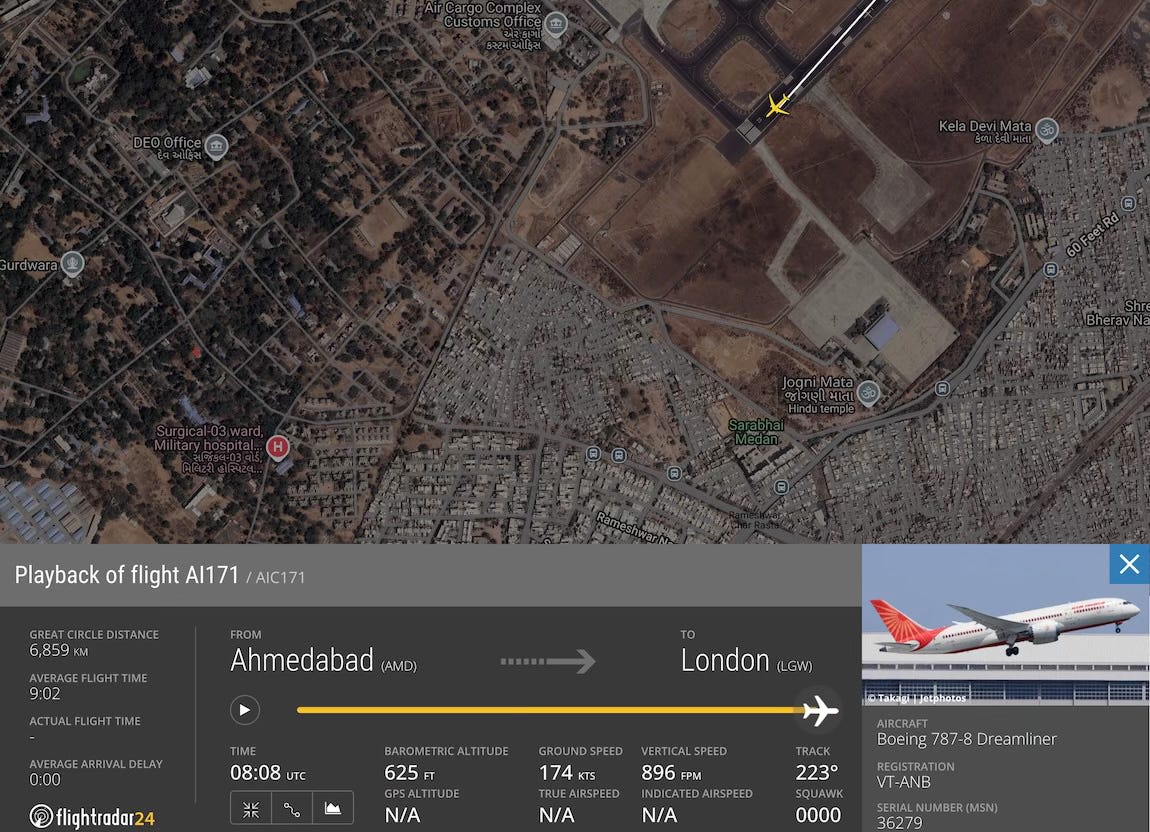Air India 171 Crash: Latest Findings and What’s Behind the Headlines as of today June 18, 2025
What pilots, experts, and officials are saying so far.
I know many of you have been following the tragic Air India crash that occurred on June 12th, and understandably, this event has raised concerns about flight safety. As someone who writes for nervous flyers, I want to provide you with a clear, honest assessment of what happened, what investigators are discovering, and most importantly, what this means for aviation safety overall.
What Happened: The Basic Facts
Air India Flight 171, a Boeing 787-8 Dreamliner, was carrying 242 people from Ahmedabad, India to London Gatwick on June 12, 2025. Shortly after takeoff within about 50 seconds, the aircraft experienced a catastrophic emergency and crashed into a medical college building. Tragically, only one person survived.
This was the first time a Boeing 787 Dreamliner has been completely lost in an accident, which is significant given that this aircraft type has been flying since 2011 and has an excellent safety record.
What Investigators Are Finding: The Technical Picture
The investigation is still in its early stages, but several important clues have emerged that help us understand what likely went wrong. However, it's crucial to note that there have been false reports circulating online, including AI-generated content from sources like ChatGPT claiming electrical system failures that are not supported by actual evidence. As we discuss the facts below, please be aware that misinformation can spread quickly after major aviation incidents, and it's important to rely on official investigative sources.
The Ram Air Turbine Deployment
One of the most telling pieces of evidence is that the aircraft's "Ram Air Turbine" (RAT) was deployed during the flight. Think of the RAT as an emergency backup generator, it's a small propeller that pops out of the aircraft when both engines fail or when there's a major loss of electrical and hydraulic power. The RAT only deploys in truly serious emergencies, so seeing it tells investigators this was likely a dual engine failure or major systems failure.
More on RAT here 👉 ✈️ Hidden Heroes of the Sky: The 5 Backup Systems That Keep You Safe on Every Flight
The MAYDAY Call and Cockpit Voice Recorder
The crew issued a MAYDAY call reporting "thrust failure," which confirms they were dealing with engine problems. This wasn't a silent emergency the pilots were aware of the problem and trying to manage it.
Importantly, investigators have recovered the Cockpit Voice Recorder (CVR) one of the two "black boxes" and it's reported to be in good condition. This device records all conversations and sounds in the cockpit during the flight, giving investigators a clear picture of what the crew experienced and how they responded to the emergency. Early indications suggest the pilots worked diligently to try to save the aircraft and manage the crisis they were facing.
As a pilot myself, I can tell you that when you experience a thrust failure immediately after takeoff, the first instinctive reaction, pure muscle memory from countless hours of training is to slam those power levers full forward together with your co-pilot. It's an automatic response drilled into every commercial pilot: maximum power, now.
This follows what we call the quick PPAA sequence that every pilot learns from their very first days in small aircraft training:
Power (apply maximum available power)
Performance (assess if the aircraft is climbing, maintaining altitude, or descending, retract the landing gear and later Slats/Flaps)
Analyse (determine what's wrong and what options you have)
Action (execute the appropriate emergency procedures). These are the absolute basics of aviation emergency management, trained into us until they become second nature.
The fact that even with maximum power applied, this aircraft couldn't maintain its climb tells us just how severe this emergency was.
Flight Pattern Analysis
Video footage and flight data show the aircraft stopped climbing about 50 seconds after takeoff and began descending. The landing gear appeared to still be down when it would normally be retracted, which creates additional drag and makes it nearly impossible for an aircraft to climb effectively.
What Could Have Caused This?
Investigators are examining several possibilities, and it's important to understand that modern aviation investigations look at multiple potential causes:
1. Dual Engine Failure
This appears to be the leading theory based on the RAT deployment and MAYDAY call. Dual engine failures are extremely rare—we're talking about odds of less than one in a billion flight hours. When they do occur, it's usually due to:
Fuel system problems affecting both engines
Ingestion of foreign objects (like birds) into both engines
Extremely rare manufacturing defects
Vapor lock in jet engines (though rare) could happen if fuel turns into vapor before reaching the engine, instead of staying as liquid. This can block fuel flow or reduce pressure, starving the engine of fuel and causing a loss of power. It might occur due to extreme heat or sudden pressure changes in the fuel system.
2. Aircraft Configuration Issues
Investigators are looking at whether the flaps (wing surfaces that help with lift during takeoff) were set correctly, and why the landing gear wasn't retracted normally as always just after take-off and a positive climb is achieved.
3. Environmental Factors
The temperature in Ahmedabad was about 40°C (104°F) that day. Hot weather reduces air density, which affects engine performance and the aircraft's ability to climb. However, airlines and pilots routinely operate in these conditions with proper procedures.
4. System or Software Issues
Modern aircraft like the 787 have sophisticated computer systems that manage engine thrust. Investigators are examining whether any of these systems may have malfunctioned.
What This Means for You as a Nervous Flyer
I understand that reading about aircraft accidents can be deeply unsettling, especially when you're already anxious about flying. Here's what I want you to know:
This Was an Extremely Rare Event
The Boeing 787 has flown millions of flights safely since entering service. This is the first hull loss (complete destruction) of a 787 in commercial service. The aircraft type has an exceptional safety record.
Multiple Systems Failed Simultaneously
What appears to have happened to Flight 171 required multiple, simultaneous failures something aviation systems are specifically designed to prevent. Commercial aircraft have redundant systems precisely so that single failures don't lead to accidents.
The Investigation Process Works
The thorough investigation now underway will identify exactly what went wrong and lead to improvements that make flying even safer. Both black boxes have been recovered, giving investigators excellent data to work with. We should hear more in the next few days…
Airlines Are Taking Immediate Action
India's aviation authority has ordered enhanced inspections of all Boeing 787s in the Indian fleet. When the aviation industry identifies potential risks, it acts quickly to address them.
The Broader Context: Why Flying Remains Remarkably Safe
It's natural to focus on this tragedy, but it's important to maintain perspective:
Commercial aviation is safer than it has ever been. Fatal accidents have declined dramatically over the past decades despite massive increases in air traffic.
Every accident leads to improvements. The aviation industry's commitment to learning from every incident, no matter how rare, is what makes flying so safe.
Pilots train extensively for emergencies. The cockpit voice recorder, which is in excellent condition, indicates that the crew of Flight 171 worked tirelessly to manage the emergency and appeared to have attempted to steer away from populated areas, potentially saving additional lives even in their final moments. Their professionalism under extreme pressure exemplifies the caliber of training commercial pilots receive.
Modern aircraft are incredibly robust. The fact that this is the first 787 hull loss after millions of flights demonstrates the remarkable engineering that goes into modern aircraft.
What Happens Next
The investigation will likely take 12-18 months to complete fully, but preliminary findings may emerge within a few months. Based on what investigators learn:
Aircraft manufacturers may issue service bulletins or modifications
Airlines may update their procedures
Training programs may be enhanced
Regulatory authorities may issue new requirements
This is how aviation safety continuously improves, each rare event teaches the entire industry how to be safer.
For the latest verified developments on this investigation: The Aviation Herald a trusted source for factual aviation incident reporting.
A Personal Note
I know that as nervous flyers, you might be wondering whether you should change your travel plans or avoid flying altogether. As someone who understands flight anxiety, I want to be completely honest with you: this accident, while tragic, doesn't change the fundamental safety of commercial aviation.
The Boeing 787 remains one of the world's safest aircraft. The investigation will make it even safer. Your upcoming flights are statistically as safe as they were before this accident occurred.
If you're feeling particularly anxious about flying right now, that's completely understandable and normal. Consider:
Talking to a mental health professional who specializes in flight anxiety
Get my Ebook 📱 "Fly Calm" to lower your anxiety
Reviewing the actual statistics on aviation safety
Remembering that millions of flights operate safely every single day
Looking Forward
I'll continue to follow this investigation and provide updates as meaningful new information becomes available. The aviation industry's transparency in investigating accidents is one of its greatest strengths, we will learn exactly what happened and how to prevent it from happening again.
In the meantime, remember that every flight you take benefits from lessons learned from incidents like these. The dedication of investigators, engineers, pilots, and safety professionals to continuous improvement is what makes commercial aviation the safest form of travel humans have ever devised.
Stay safe, and remember your fear is understandable, but the skies remain remarkably safe.
If you found this analysis helpful, please share it with others who might benefit from understanding this incident in context. And as always, if you have specific questions about flight safety or managing flight anxiety, don't hesitate to reach out.
Pilot Nick
Sources and Further Reading:
Aircraft Accident Investigation Bureau (India)
U.S. National Transportation Safety Board reports
Aviation safety databases and analysis
Boeing 787 safety and operational data
For the latest verified developments on this investigation: The Aviation Herald - a trusted source for factual aviation incident reporting








Great information and analysis!
A lot of factors to consider and eliminate to arrive at an answer. Usually the case. It’s almost never one issue.